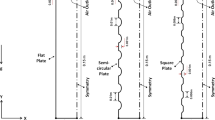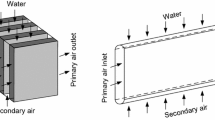Abstract
This paper presents a study on a novel water bubbling layer pressure drop and heat transfer experiment that was conducted to investigate the characteristics of pressure drop of air flow across the water bubbling layer. The attempt was to reduce the pressure drop while maintaining a higher value of the heat transfer coefficient. This type of heat transfer between water and merged tubes has potential application in evaporative cooling. To achieve the goal the pressure drop should be reduced by decreasing the bubble layer thickness through the water pump circulation. Pressure drops of air passing through the perforated plate and the water bubbling layer were measured for different heights of water bubbling layer, hole-plate area ratio of the perforated plate and the air velocity through the holes. Experimental data show that the increase of water bubbling layer height and air velocity both increase the pressure drop while the effect of the hole-plate area ratio of the perforated plate on the heat transfer coefficient is relatively complex. The measurements showed that even at a considerably lower height of water bubbling layer the heat transfer coefficient can exceed 5,000 W/m2-K. The heat transfer coefficients of 30 mm high water bubbling layer are higher than that of other higher water bubbling layers tested in the experiments









Similar content being viewed by others
Abbreviations
- A h :
-
total area of the plate holes (m2)
- h :
-
heat transfer coefficient (kW/(m2 °C))
- H :
-
height of the bubbling layer (mm)
- q :
-
heat flux (kW/m2)
- \( \overline{t} _{{water}} \) :
-
average water temperature (°C)
- \( \overline{t} _{{wall}} \) :
-
average tube wall temperature (°C)
- u f :
-
frontal air velocity of the perforated plate (m/s)
- u s :
-
superficial air velocity (m/s)
- V :
-
airflow rate (m3/s)
- ΔP :
-
pressure drop (Pa)
- S :
-
perforated plate area (m2)
- W :
-
flow rate (kg/h)
- β :
-
hole-plate area ratio
- A :
-
dry air
- exp :
-
experimental data
- p :
-
dry plate
References
Wang Q, Dudukovic MP (1996) A two phase recycle with cross-flow mixing model (trcf) for churn turbulent bubble column reactors. In: Paper presented at the AIChE annual meeting, Chicago
Dudukovic MP, Devanathan N (1993) Bubble column reactors: some recent developments, in chemical reactor technology for environmentally safe reactors. In: DeLasa HI et al (eds) NATO ASI Series E: Appl Sci 225:379–408
Kumar SB, Devanathan N, Moslemian D, Dudukovic MP (1994) Effect of scale on liquid recirculation in bubble columns. Chem Eng Sci 49(24B):5637–5652
Adkins DR, Shollenberger KAl, O’Hern TJ, Torczynski JR (1996) Pressure effects on bubble column flow characteristics. In: ANS proceedings of the national heat transfer conference, thd-vol 9. American Nuclear Society, LaGrange Park, pp 318–325
Mizushina, Miyashita (1968) A new design of gas-liquid contacting heat exchanger. J Chem Eng Jpn 32(10):987–992
Kim JH, Simon TW, Viskanta R (1993) Journal of heat transfer policy on reporting uncertainties in experimental measurements and results (Editorial). ASME J Heat Transfer 115(1):5–6
Moffat RJ (1985) Using uncertainty analysis in the planning of an experiment. ASME J Fluids Eng 107(2):173–178
Acknowledgments
The authors, Qinghua Chen, Wenzhi Cui, and Longjian Li, acknowledge the support of this work by the National Nature Science Foundation of China Grant no: 50276073. The authors would like to express gratitude to the NSF by funding this research under grant NSF CTS970045N, CMS9821057 and CTS000003N for supporting Qinghua Chen.
Author information
Authors and Affiliations
Corresponding author
Rights and permissions
About this article
Cite this article
Chen, Q., Amano, R.S., Cui, W. et al. The pressure drop characteristics of air–water bubbling flow for evaporative heat transfer. Heat Mass Transfer 44, 779–785 (2008). https://doi.org/10.1007/s00231-007-0309-9
Received:
Accepted:
Published:
Issue Date:
DOI: https://doi.org/10.1007/s00231-007-0309-9




